A new era dawns at Barcelona. Ronald Koeman has been sacked following a series of bad results and now, it’s time for the prodigal son, Xavi Hernandez, to take over and lead the Catalans back to their best. The former legendary midfielder has been in a managerial role for a couple of years now, creating a domestic monster in Qatar with Al Sadd. Now, a new challenge awaits him in LaLiga where Real Madrid and co. are threatening to push Barcelona even deeper into the abyss.
But even though a lot is known about Xavi the player, Xavi the manager is still a largely fresh figure in the world of football. For that reason, this tactical analysis will break down his tactics and use analysis to determine how he could set up camp at Barcelona.
Basic principles
‘Take the ball, pass the ball’ goes one of Barcelona’s unofficial mottos, as presented by the legends of the club including Pep Guardiola and Xavi himself in the movie by the same title. We know Barcelona are a possession-heavy side that loves to have the ball at all times and dominate the opposition through possession. Xavi bases his philosophy on the very same foundations.
With over 60% possession at Al Sadd in 2021/22, it’s safe to say he’s successfully put words into action. Xavi’s team can be described as an all-attacking side that will rather concede four goals while scoring six than defend a 1-0 lead. Another very basic principle he believes is core to his philosophy is superiority. Establishing superiorities across the pitch, whether that’s numerical, qualitative or dynamic, is key to success.
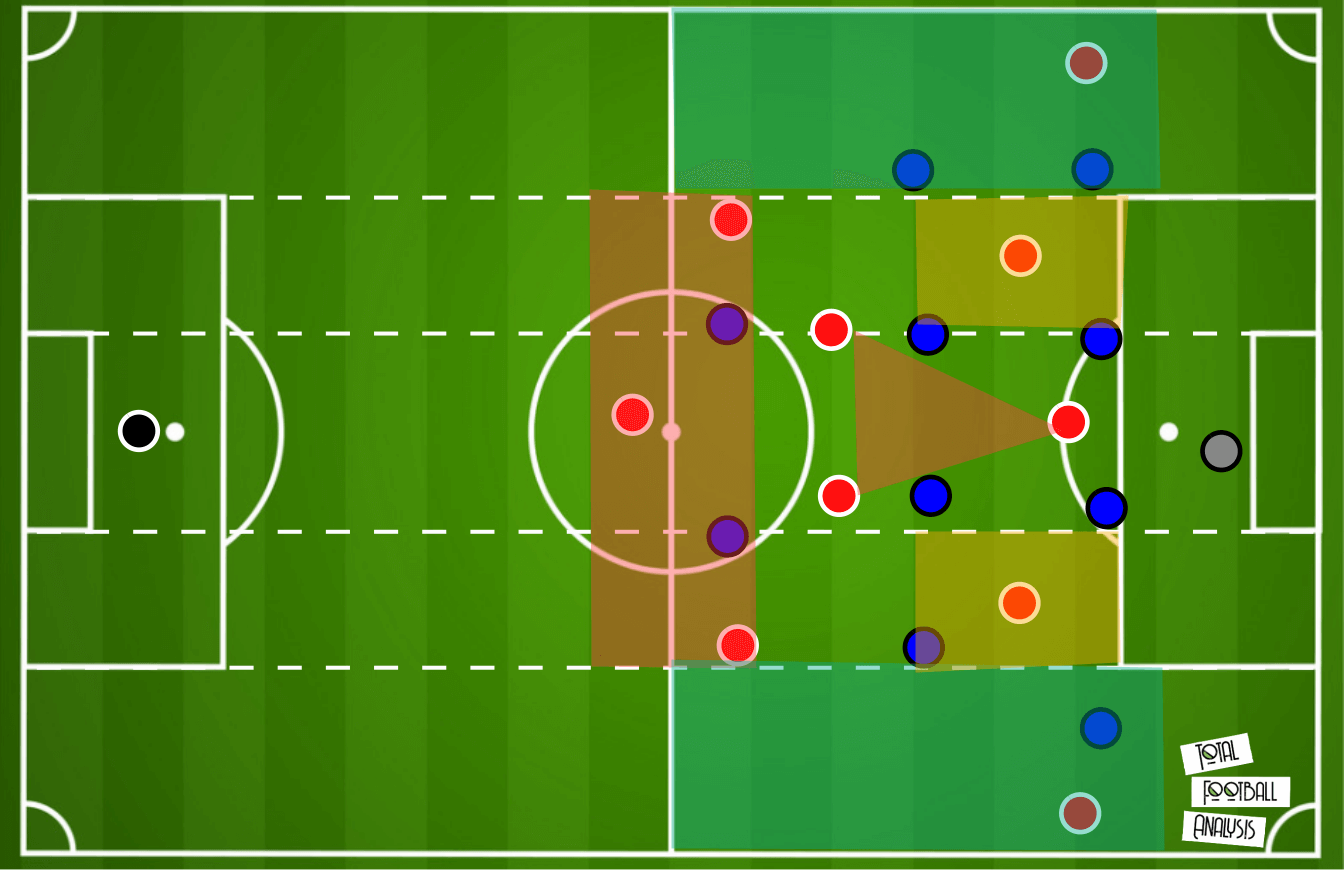
Above, you can see some of his basic principles visualised in one tactical board image. I’ve highlighted several areas of interest when attacking the opposition’s defensive block. In the first phase of build-up, Xavi loves to adhere to the +1 rule which states that you only ever need one additional player to successfully transition the attack into the next phase of play.
If the opposition is pressing in a 4-4-2, for example, you would need three players in the first phase to achieve superiority and make the progression sequence easier. If the opposition press in a 4-3-3, an additional player would drop into the first line to again create the +1 situation. Another area where superiority is often achieved is in the central channels. With two pivots, two interiors and a striker, Xavi uses constant movement to overload the opposition’s second line of defence.
A striker can drop to create a 3v2 situation or the same can be done with the interiors moving deeper from their half-space positions. Generally, however, they will ideally occupy the area highlighted in yellow in the image above. That’s where the ball needs to go and from there, key sequences are then played further forward, which will be dissected further down the line of this tactical analysis. The next principle we need to touch upon is width.
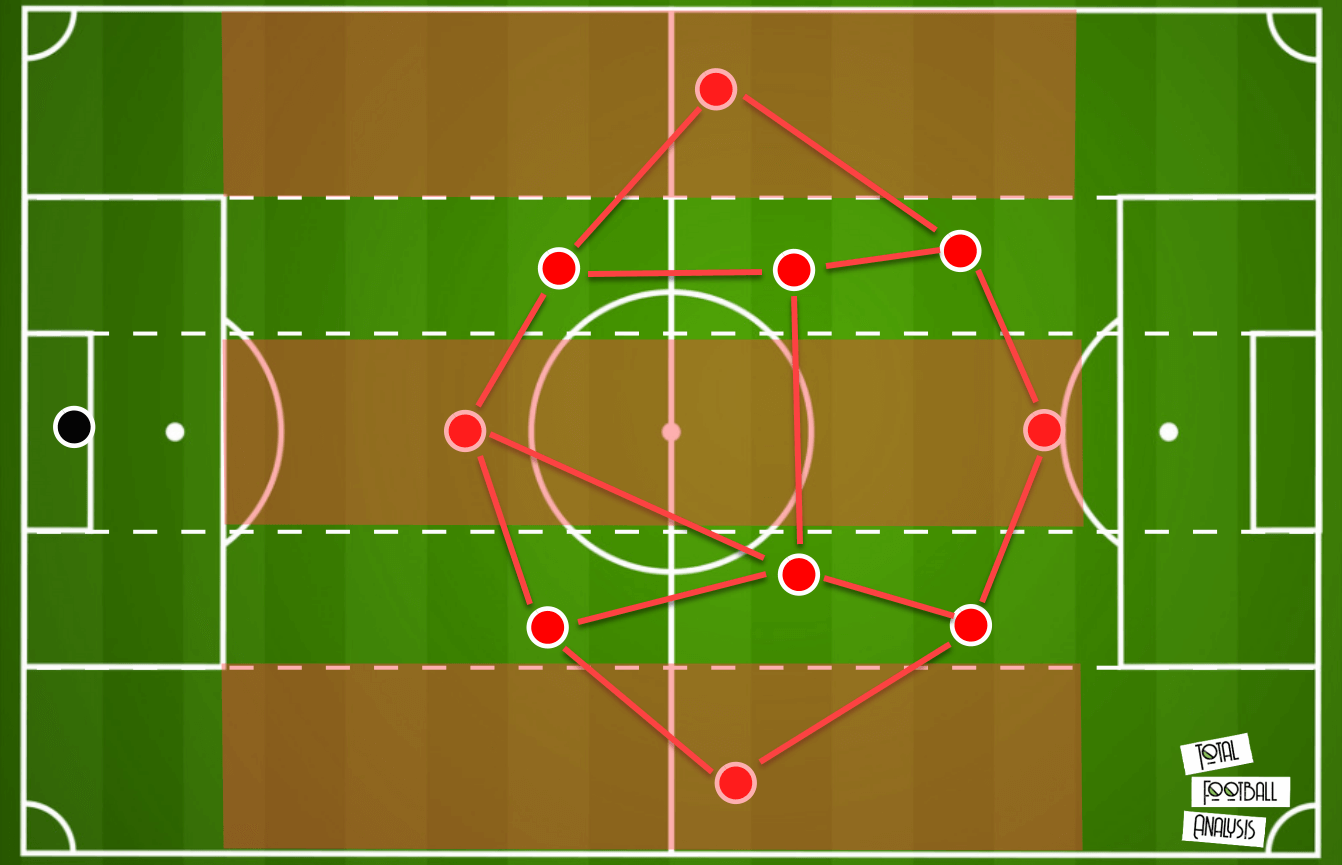
Width is absolutely essential to Xavi and his tactics but the way it’s accomplished depends largely on the personnel and system used. At Al Sadd, he used a 3-4-3 and a 4-2-3-1, using wingbacks for width in the former and wingers in the latter case. Above is his basic 3-4-3 structure that utilises three centre-backs, two wingbacks, two pivots, two interiors or inverted forwards and a striker.
There are a couple of things worth noting here. The first one is the wide positioning of the wingbacks, who are generally involved in the build-up in the first phase but then bombard forward and usually stay high up the pitch. Secondly, Xavi loves his team to occupy all five vertical channels of the pitch, once again adhering to Pep’s vision of how football should be played. The problem with transferring this system directly to Barcelona’s own tactical setup lies mostly in (available) personnel.
Barcelona traditionally play in a 4-3-3 system but in possession, that often transforms into a 3-4-3 anyway. However, as opposed to using three centre-backs, the Catalans will drop a pivot between the defenders to create a three-in-the-back structure. Taking into account the lack of options in the centre-back position, I see this as being the more likely option for Xavi too.
Admittedly, we did see him use a four-man backline too in the 4-2-3-1 system, which is somewhat different in some general aspects.
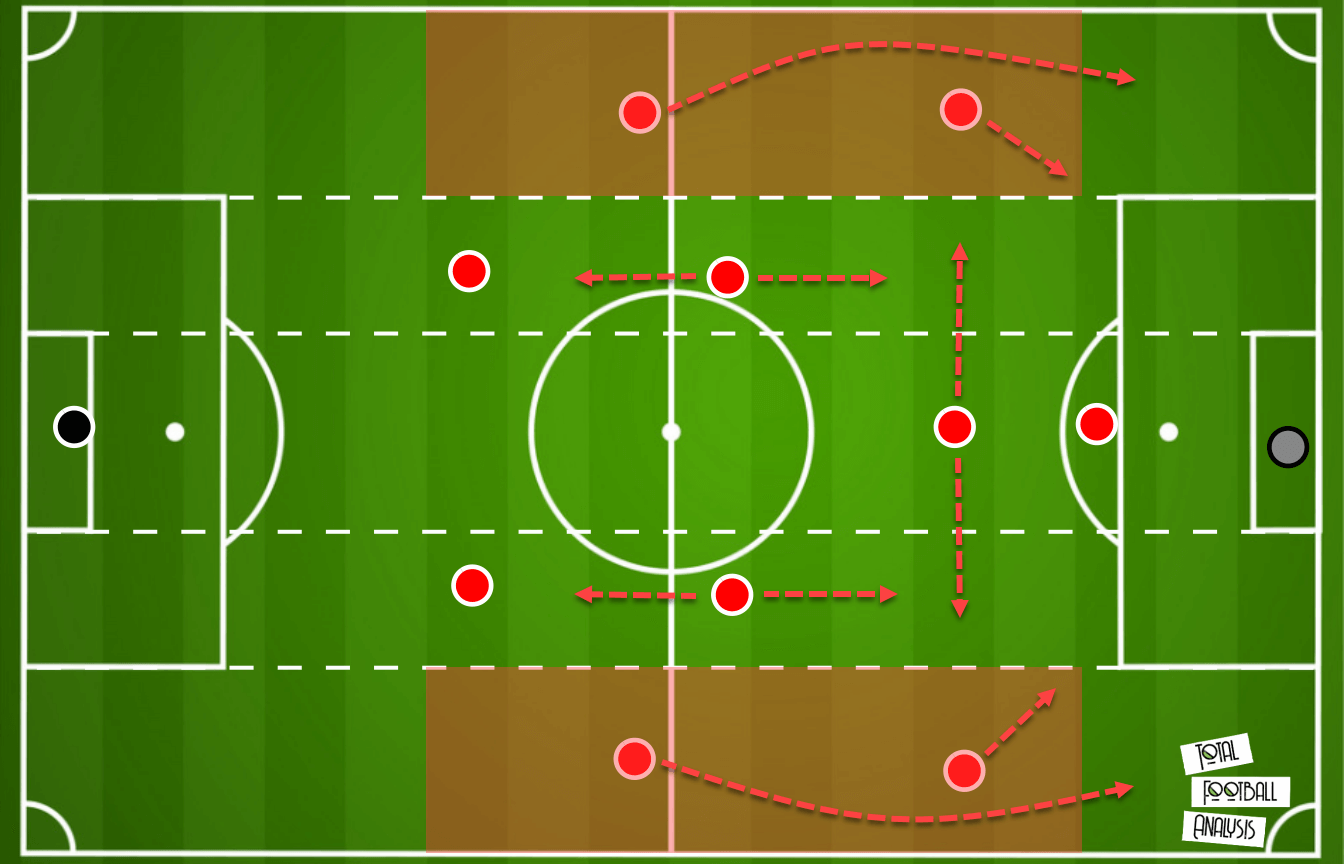
Now, the width is provided by the wingers but there is still an option for the overlap to occur. Interestingly, the wingers in this system are not necessarily inverted. Yes, they will cut slightly inside to create space for the full-backs but will generally aim to create overloads out wide alongside the full-backs rather than completely vacating the flank for them.
This system also utilises a single no.10 who is free to roam the final third and the pivots often move in opposite directions, depending on the opposition’s defensive approach. This system can once again easily transition into a three-in-the-back scenario since Xavi’s midfielders are generally free to move according to the situation at hand while also being wary of the +1 rule we discussed earlier in the analysis.
Now that we’ve established some of the core principles of Xavi’s tactics, let’s take a deeper dive into some specific phases of play.
Build-up principles
We’ve already touched upon some of the tactical concepts Xavi likes to utilise in the first phase of play but we’ll expand on it in this section of the tactical analysis of his philosophy. The main aspect here is, of course, the +1 rule. Your team must have at least one player more than the opposition when trying to build up from the back.
By constantly establishing superiorities, progression becomes much easier to achieve and it reduces the risk of losing possession deep in your half. Xavi loves to use the goalkeeper as the additional outfield player, which is something Barcelona are very comfortable doing too. Below is a graphical representation of some of the build-up sequences that Al Sadd have used so far under their now-former gaffer.
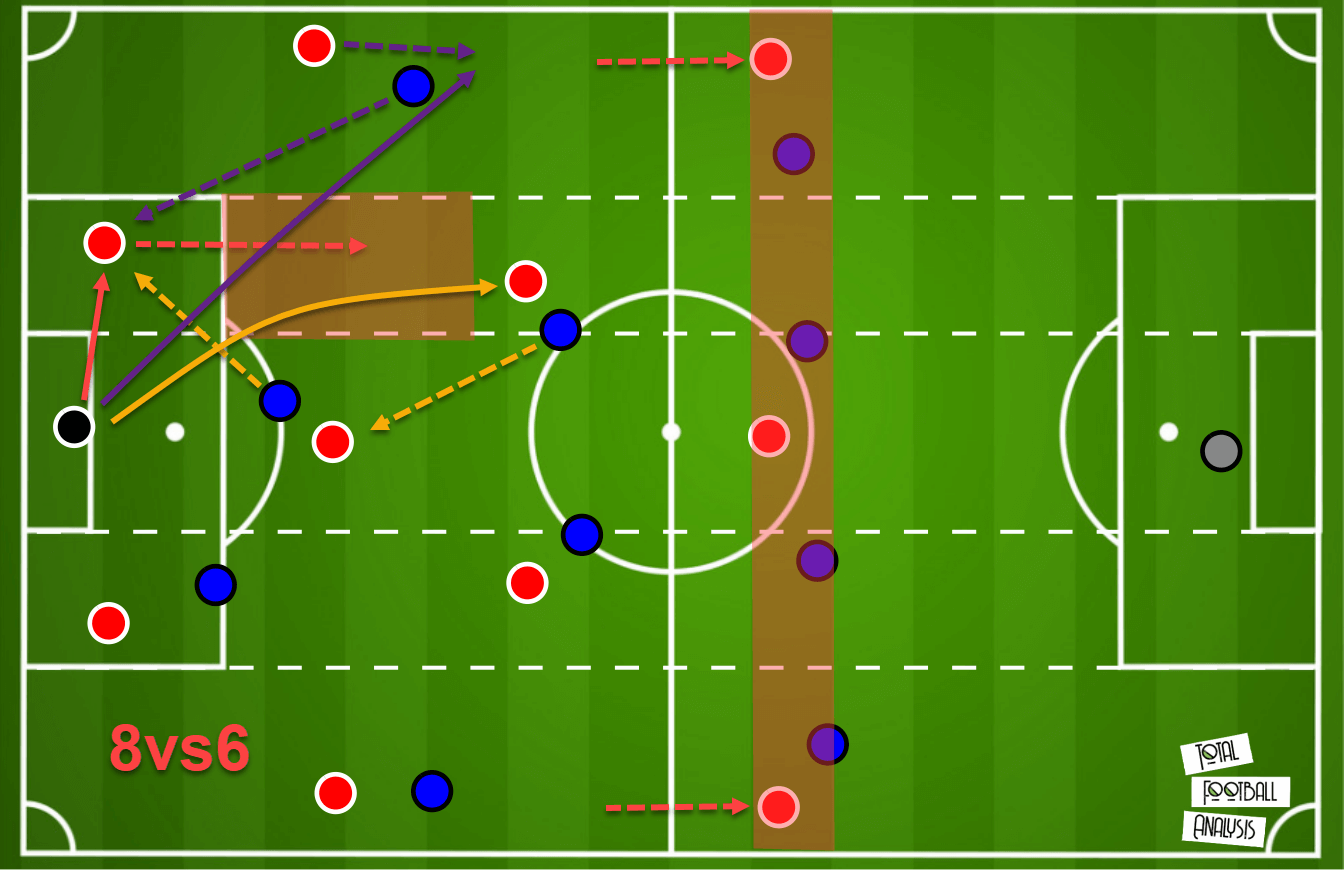
The first thing to note here is the numerical superiority achieved in their half of the pitch. The nature of the build-up from the back means the opposition goalkeeper is automatically eliminated from the equation, tilting the odds in the attackers’ favour. The second thing that’s crucial to achieving superiority is pinning the opposition backline. The wingers are high and wide while the striker occupies the two centre-backs, forcing them back towards their goal.
This not only creates a gap between their lines but also enables the 8vs6 overload to occur too. It’s difficult to outline every single sequence Al Sadd used under Xavi and this is true for all phases of play too. But there are some more general ones we can analyse here. Of course, every single one depends on the movement and the defensive system deployed by the opposition.
But as Xavi himself explained when talking about his tactics, the key is to find the ‘free man’. And there is always one, which is guaranteed once the overload has been achieved beforehand. Usually, it will be either the centre-backs or the goalie looking for the free man and while there are several sequences involving the latter in the visual above, below you can actually see the former in possession.
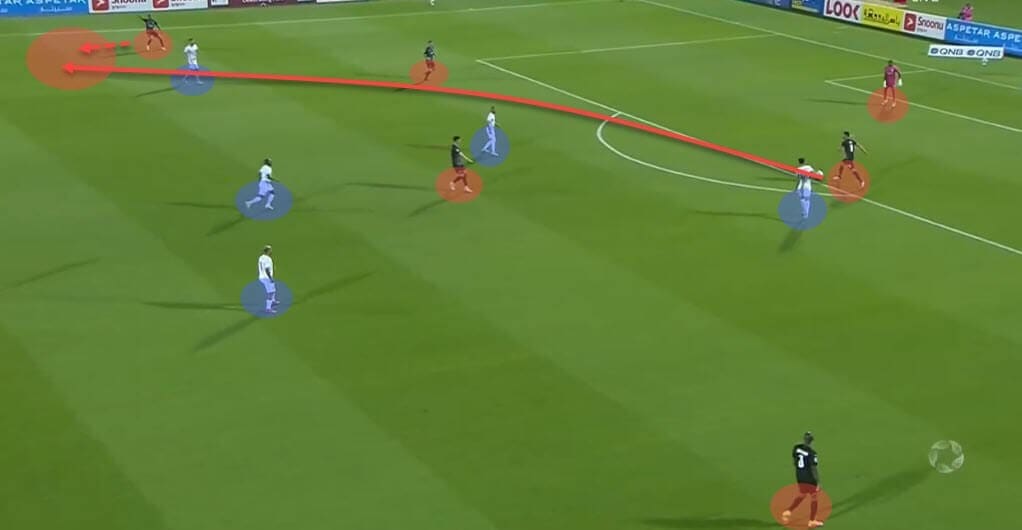
Notice the +1 rule employed in this example too – six Al Sadd players (including the goalkeeper) vs five opposition players. Once that has been established, it’s much easier to find a free man who is, by default, always available in successful overloads. But the reality of football in Qatar is that Al Sadd would rarely find worthy opponents who challenged their build-up sequences.
More often, they would face variations of 5-4-1, 4-5-1 or at the very least 4-4-2 deep blocks that looked to defend in their half rather than push out. So while playing out of pressure is something Xavi knows how to do, he is more used to trying to unlock a deep block, which we’ll discuss in the next section of our tactical analysis.
But before that, let’s explore some other principles Al Sadd used in the first phase of progression. Below we can see their basic structure when entering the opposition’s half with different roles and positioning of the players.
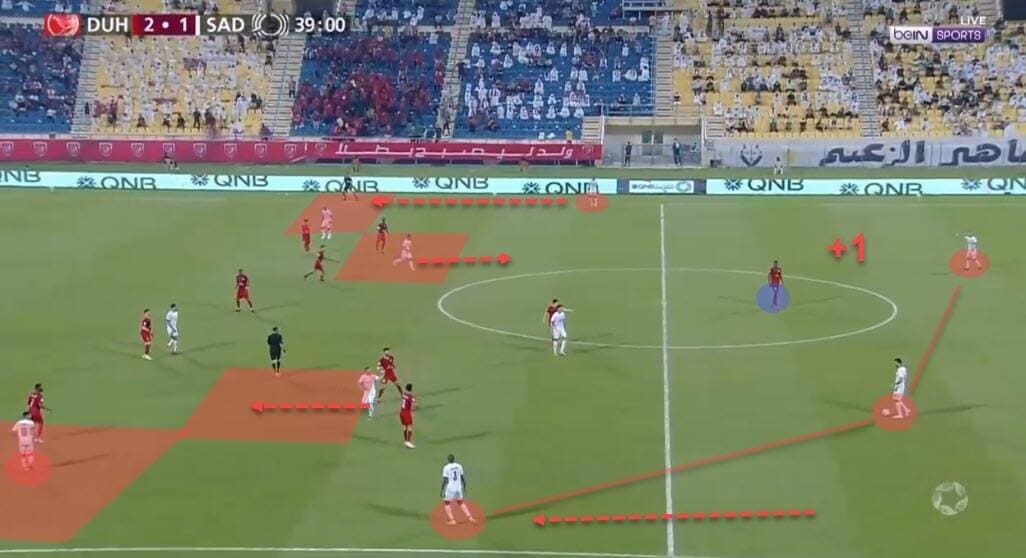
I like this example because it shows us how Xavi is adaptable and willing to make tweaks depending on the opposition’s structure. Here, his three-in-the-back is quickly transformed into a more regular centre-back tandem once the left centre-back pushes up to join the attack. That happens because he is not needed in the backline anymore.
This is the very definition of the +1 rule and this example shows it perfectly. Similarly, we see the principles of width and depth, half-space occupation, the striker pinning down the middle and the interiors’ movement. And often enough, it will be the backline that holds the key to progression.
Barcelona are largely the same and require their centre-backs to be extremely comfortable on the ball. Xavi loves vertical and penetrative passes that achieve progression through short and quick sequences. We can see a very similar thing below.
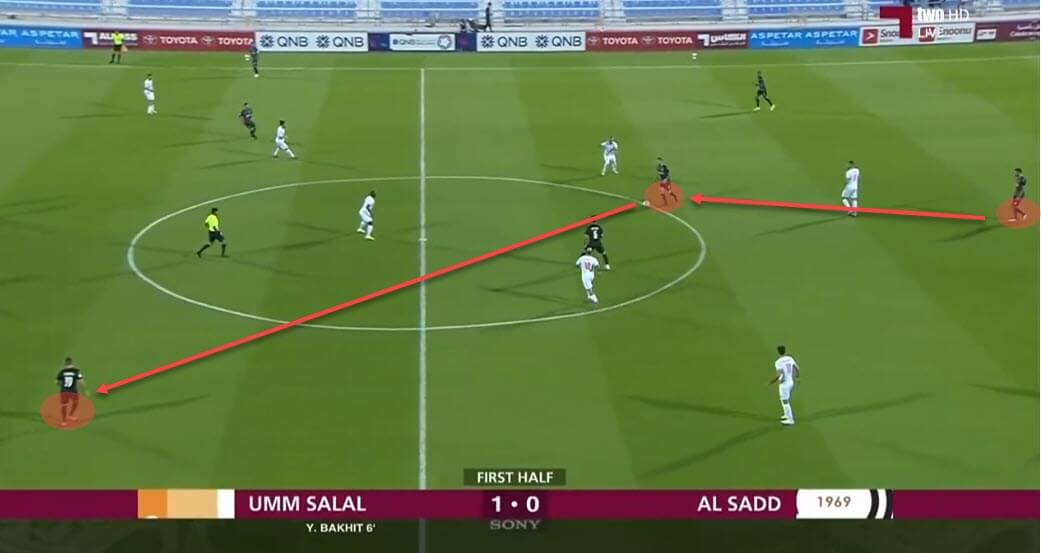
Above, Al Sadd access their key target in just three swift moves and two penetrative passes, starting from the backline. And while the defensive structure of the opposition seems to offer far too much space, the sequence is still impressively executed and fits what Barcelona want to accomplish too.
But what happens when the opposition sit back and defend within the final third of the pitch? Let’s explore Xavi’s tactics to breach a deep block.
Final third principles
Tactics to beat a deep block are always very difficult to explain. Most elite teams do indeed have a certain set of mechanisms in the final third that they follow when trying to unlock compact defences. However, while team tactics get them to the final third and then aim to set them up for success, player creativity and individual quality shine the most in this phase of attack. Xavi is very similar in this regard.
With that being said, however, we’ll still explore some of the tactics deployed by the new Barcelona coach. Generally, Xavi puts a great emphasis on the half-spaces, width and verticality in both movement and passing. These concepts are key but it’s difficult to fully explain his philosophy in just three or four words.
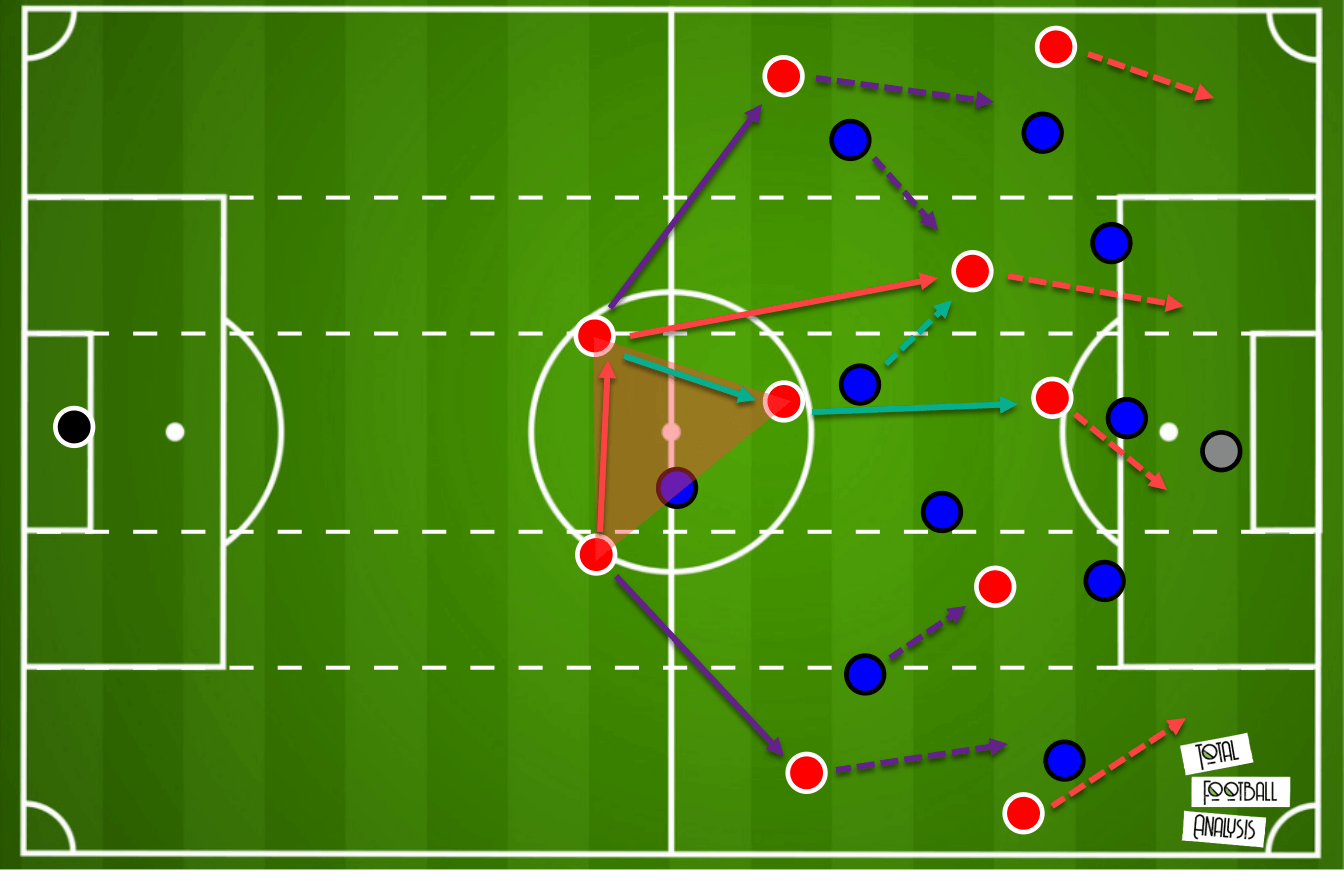
This is a more common scenario Xavi faced at Al Sadd. The opposition sits in a deep 5-4-1 block and aims to close the central channels. Depending on their approach, we can talk about several different sequences that can be deployed here. Firstly, if the wide areas are open for progression, Xavi won’t hesitate to use them.
In this scenario, both full-backs and wingers are wide and on the same vertical channel. This means overloads are possible to achieve on the opposition full-back or a runner can be found from the deep. And it’s also where verticality and width come from but Al Sadd were also very focused on the half-spaces. The interiors/inside forwards are extremely important and accessing their space is crucial.
This can be done through many different combinations, including a direct vertical ball from the backline or perhaps a three-step sequence via the pivot as we’ve seen in one of the build-up examples. Take the next sequence, for instance.
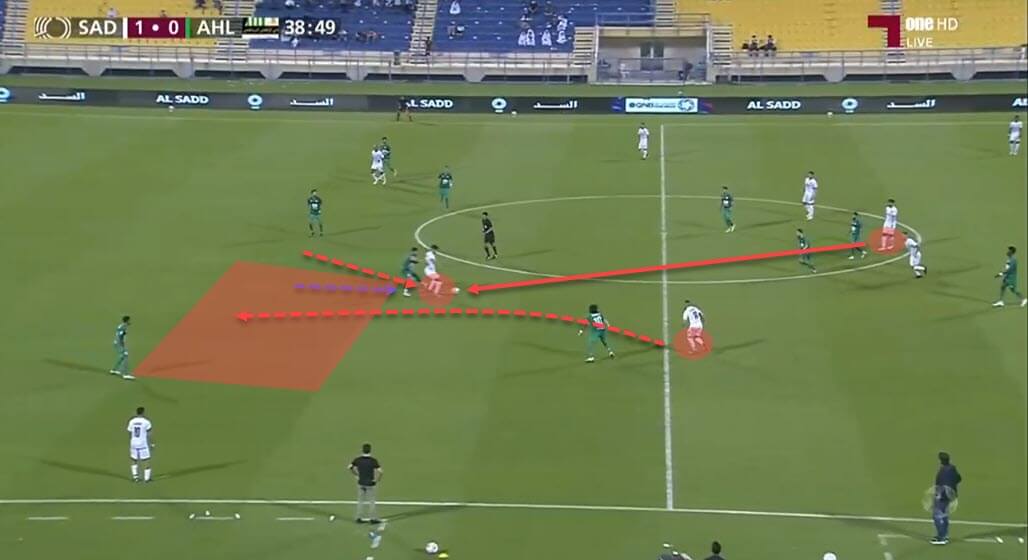
Here, the ball is played directly into the dropping striker, only to be immediately laid off moments later for the sprinting midfielder who’s attacking the half-space. We see how the space was created by pulling the marker away and then exploited straight away by someone aggressively attacking it off the ball.
Barcelona have long lacked such profiles who attack space but with Xavi’s return, the emphasis on such sequences may finally make a comeback. And this is important because the new coach definitely feels the half-space penetration is crucial in his final third tactics. Let’s take a look at another example down below.
Once again, we see Al Sadd face a deep block but this time, the player deploying the initial pass makes the run as well.
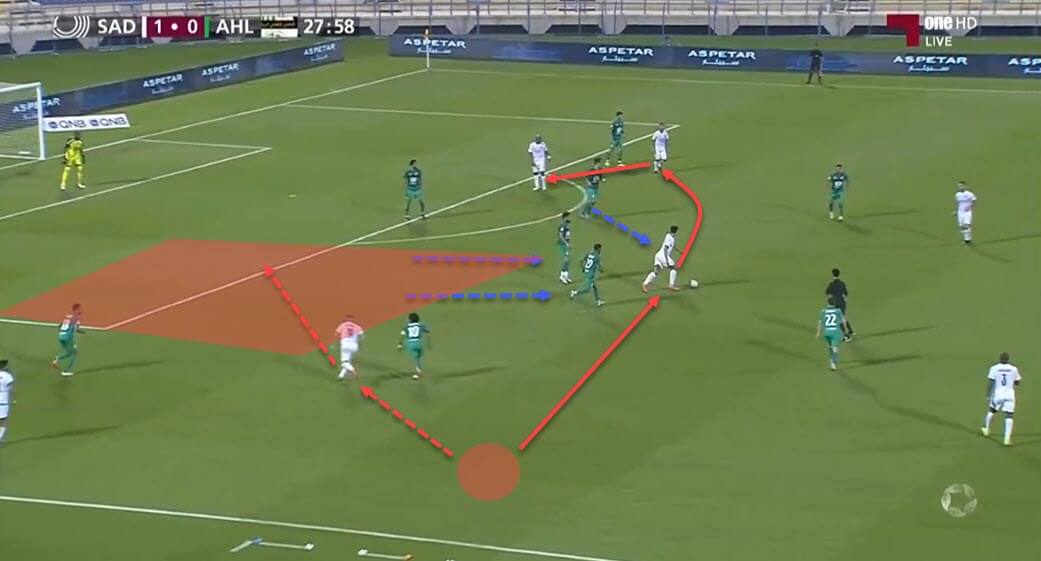
This is then followed by short and quick combinations. And while the ball ultimately doesn’t reach the player making the run, the sequence is still eerily familiar; pass and move, drag the markers and exploit space.
There’s another important aspect we have to mention before exploring something slightly different. We’ve talked about width already but it’s very important here too. Every tactical setup aims to get the best out of its players or rather, it’s trying to create the perfect scenario for the profiles it has in the squad. Xavi loves natural wingers; pacy, tricky and deadly in 1v1 situations.
So naturally, he’ll try and put them in such situations. The same goes for his wingbacks, who are dangerous when isolated out wide. Take a look at our next example, down below.
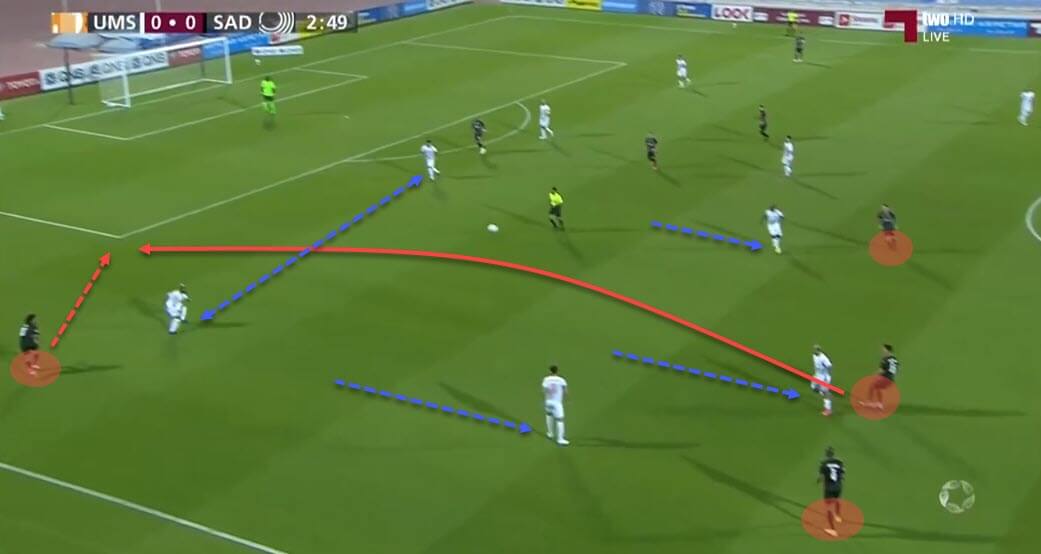
Just like with other sequences, markers get dragged away, channels widened and then a killer pass is deployed. But notice how this setup leaves the wingback isolated in a 1v1 duel with space to exploit and run into. This, of course, also depends on the available personnel. Barcelona are currently short on natural and pacy wingers but could rely on wingbacks instead.
While Xavi certainly favours the short and quick combinations, Al Sadd are a team who also didn’t shy away from deploying long switches, especially in overload to isolate tactics. The idea is rather simple but with an added ‘Xavi twist’. The team would overload one side of the pitch, only to then quickly change the angle of attack and switch the ball to the other, less populated flank.
Still, these long switches are almost always followed up by half-space penetration from the interiors or inverted forwards. Let’s take a look at one example down below. The switch is started by one of the wide centre-backs who’s aiming to find the player on the opposite flank.
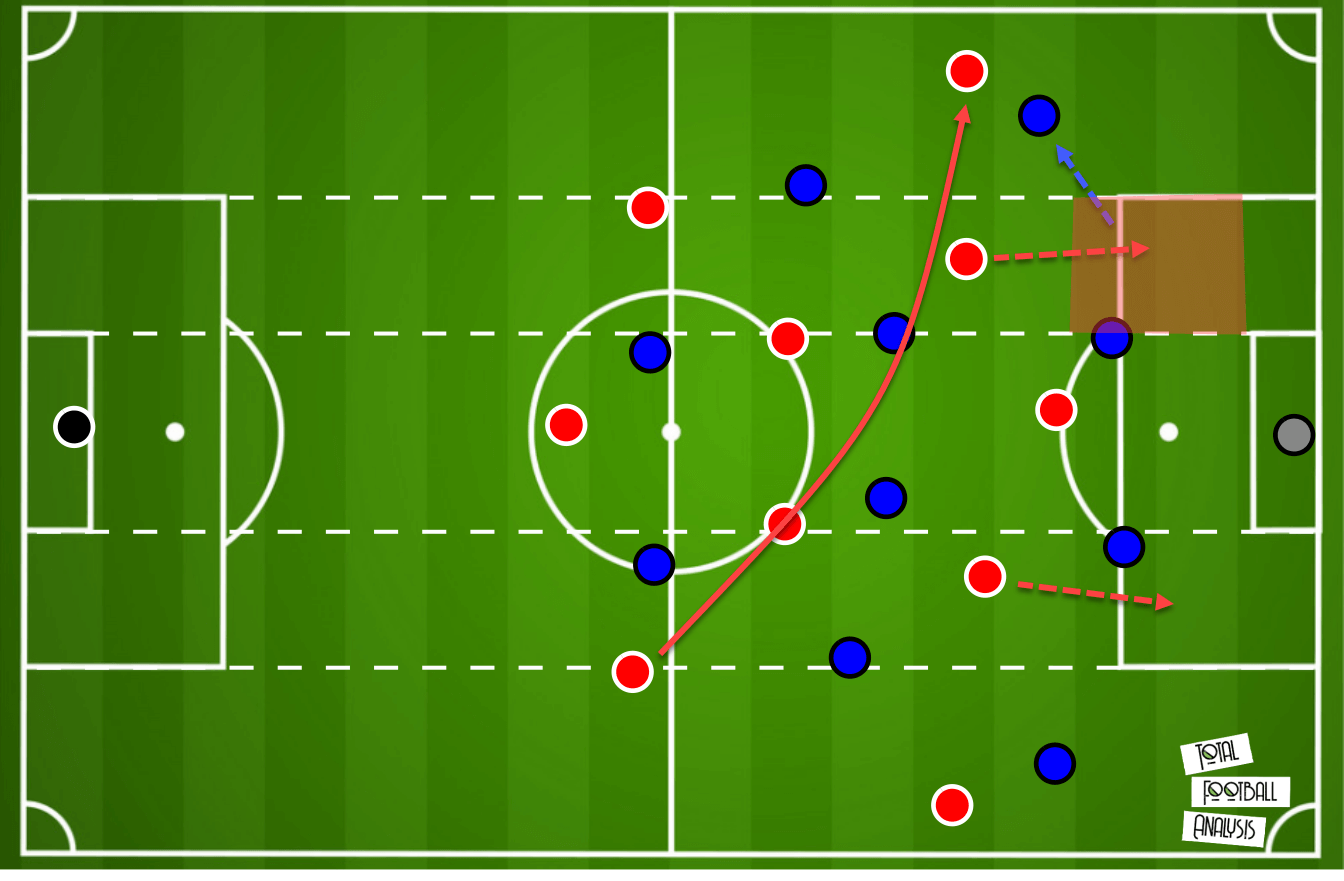
This immediately triggers the opposition full-back to press the new ball-carrier, opening up a channel for the interior at the same time. Once there’s enough space to exploit, the midfielder or the inverted forward can make that run and get into the box, preferably on the end of a ball from their wide teammate.
Here’s essentially that same sequence, only using in-game examples.
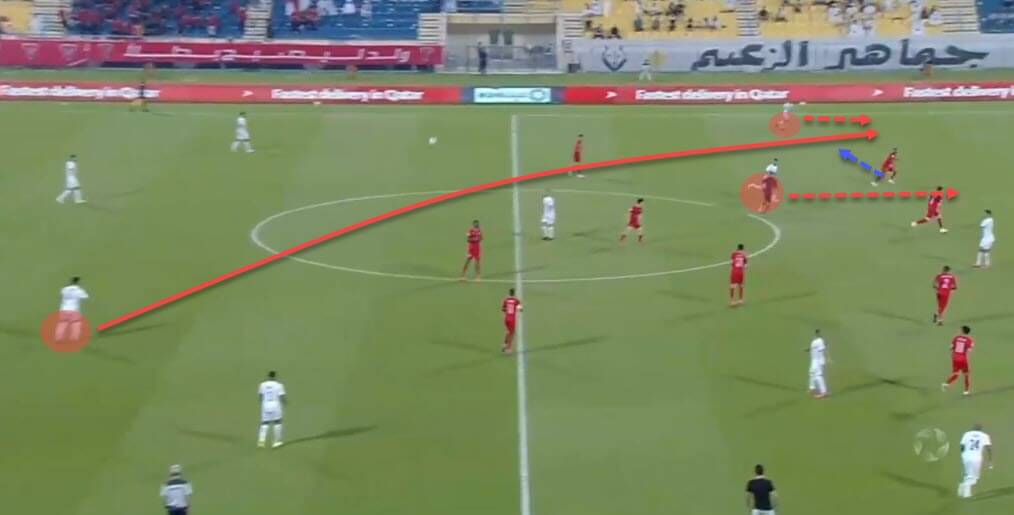
These are, of course, just some of the examples of final third tactics we can mention as a lot of them are situational and depend on the opposition’s setup. But the general principles always remain – width, verticality and constant movement.
Defending principles
The final part of our tactical analysis of Xavi’s tactics and philosophy will deal with his defensive setup. This is arguably the weakest part of his manager profile but even with that being said, there is a clear approach and an idea here to dissect too. Just as many would’ve expected, the new Barcelona coach is very aggressive in his approach to defending.
Generally, Xavi deploys a man-marking tactic that effectively mimics the opposition’s structure and aggressively follows the ball. We can see that set-up in the following image down below.
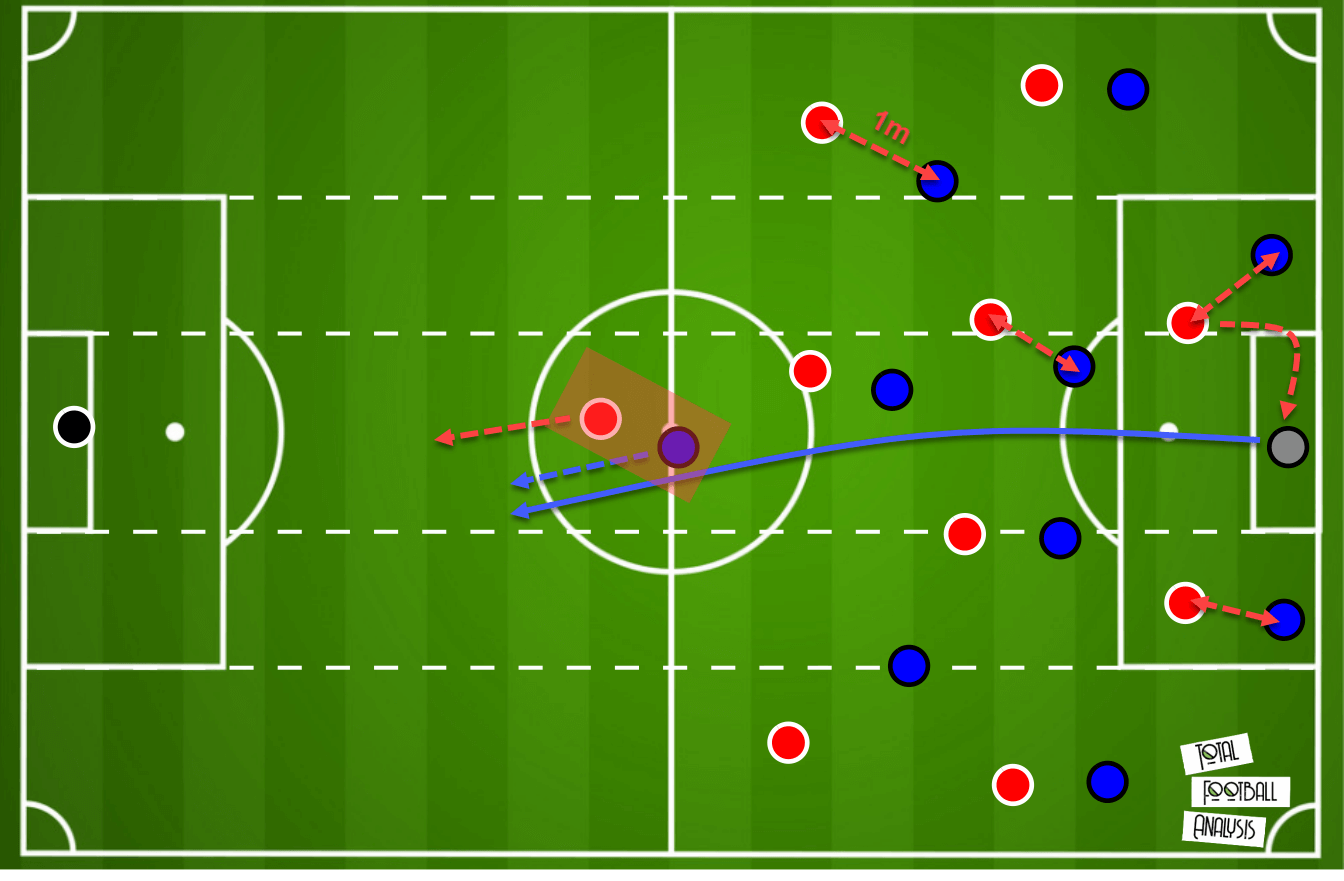
There are a couple of very important aspects we have to note here. Firstly, Xavi will take the risk of marking every player man for man, leaving the opposition forward potentially isolated with just one marker. To counter this and give his defenders a better chance of winning the direct duel, he instructs them to position themselves one metre behind their counterparts. This, in theory, gives them a head start should the duel indeed be decided in a foot race.
The opposition will often go long to combat this type of pressing but blind clearances are welcome in such scenarios. Note, also, how the striker who follows the ball will make a curved run to close the immediate passing option to the goalkeeper. This is another element that ensures the opposition goes long rather than short. The ultimate goal is always to win possession as high up the pitch as possible.
Here’s another example, this time with an in-game screenshot.
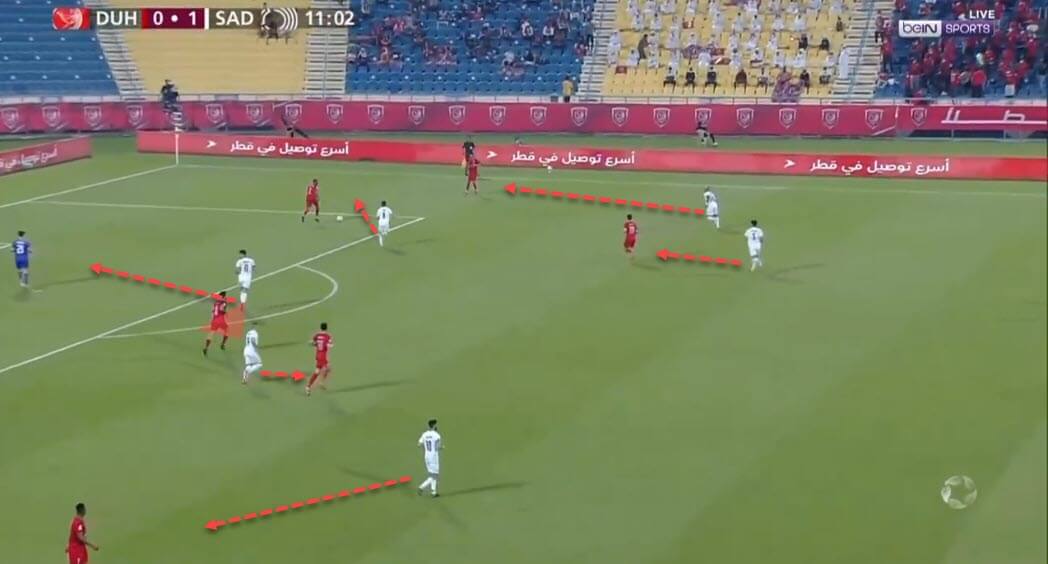
Of course, we have to highlight the danger of such an approach, which was also briefly mentioned at the beginning of this section of our tactical analysis. The opposition has a good chance of successfully isolating their forwards with Xavi’s defence because of the aggressive man-marking approach deployed further up the pitch.
Yes, the one-metre rule can and does help at times, but it’s difficult to leave players with so much room to receive and potentially turn with the ball. And in case the aerial duel and/or the subsequent second ball are lost, the team is suddenly in a very dangerous position.
Take the next sequence as a great example. Even though Al Sadd ultimately snuff out the attack, it still shows the dangers of this system quite well.
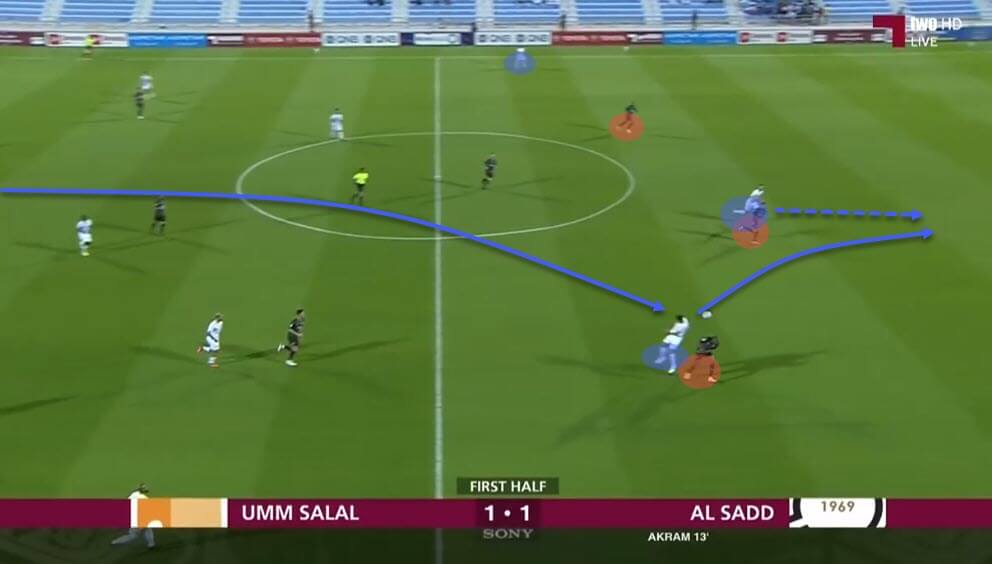
Before wrapping up this analysis, let’s quickly touch upon rest defence, as that is a big aspect Barcelona need to improve upon, among other things. Xavi’s 3-4-3/3-2-5 system combats this problem by deploying a box of five players in the first phase of build-up, aiming to solidify the in-possession structure in case of a turnover.
The base of five players is tasked to quickly plug the holes if and when the ball is lost and while it’s been far from perfectly deployed at Al Sadd, it’s still a good foundation to build on. Here’s the example down below.
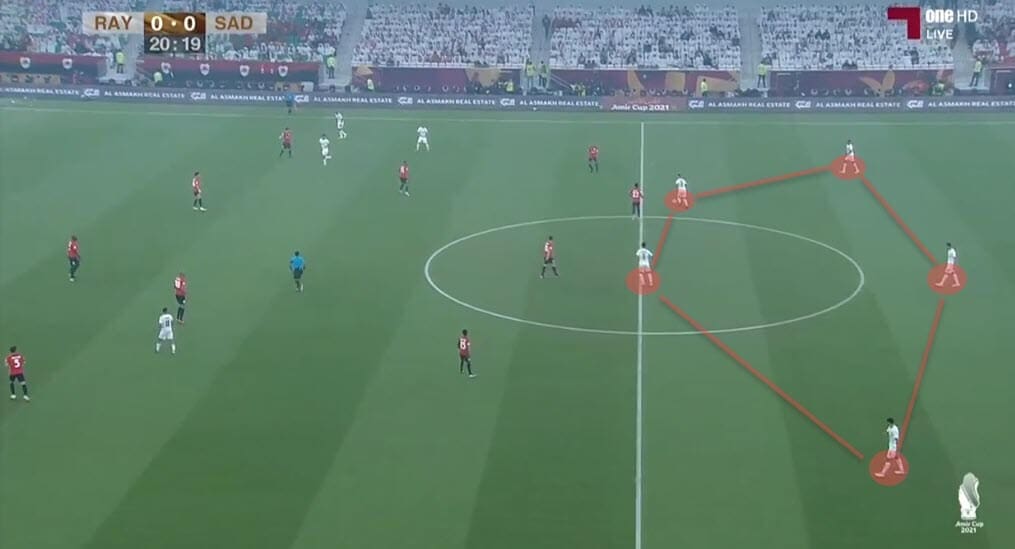
But there is no doubt, Xavi could have his hands full with Barcelona’s defensive fragility that’s been plaguing the team for season upon season.
Final remarks
Currently, Barcelona are in a very dire situation. The project has been extremely flawed for years and with the departure of Lionel Messi, the cracks have become far too big to hide. Xavi comes in with limited experience, a very limited budget and perhaps expectations that are both too high and unfair given the situation.
However, as a true disciple of Pep and Johan Cruyff, he is the prodigal son destined to restore Barcelona’s greatness. Of course, there are no guarantees in football. Can Xavi be the Catalans’ next big coaching thing? Absolutely. Is he going to be? Well, we’ll just have to wait and see.

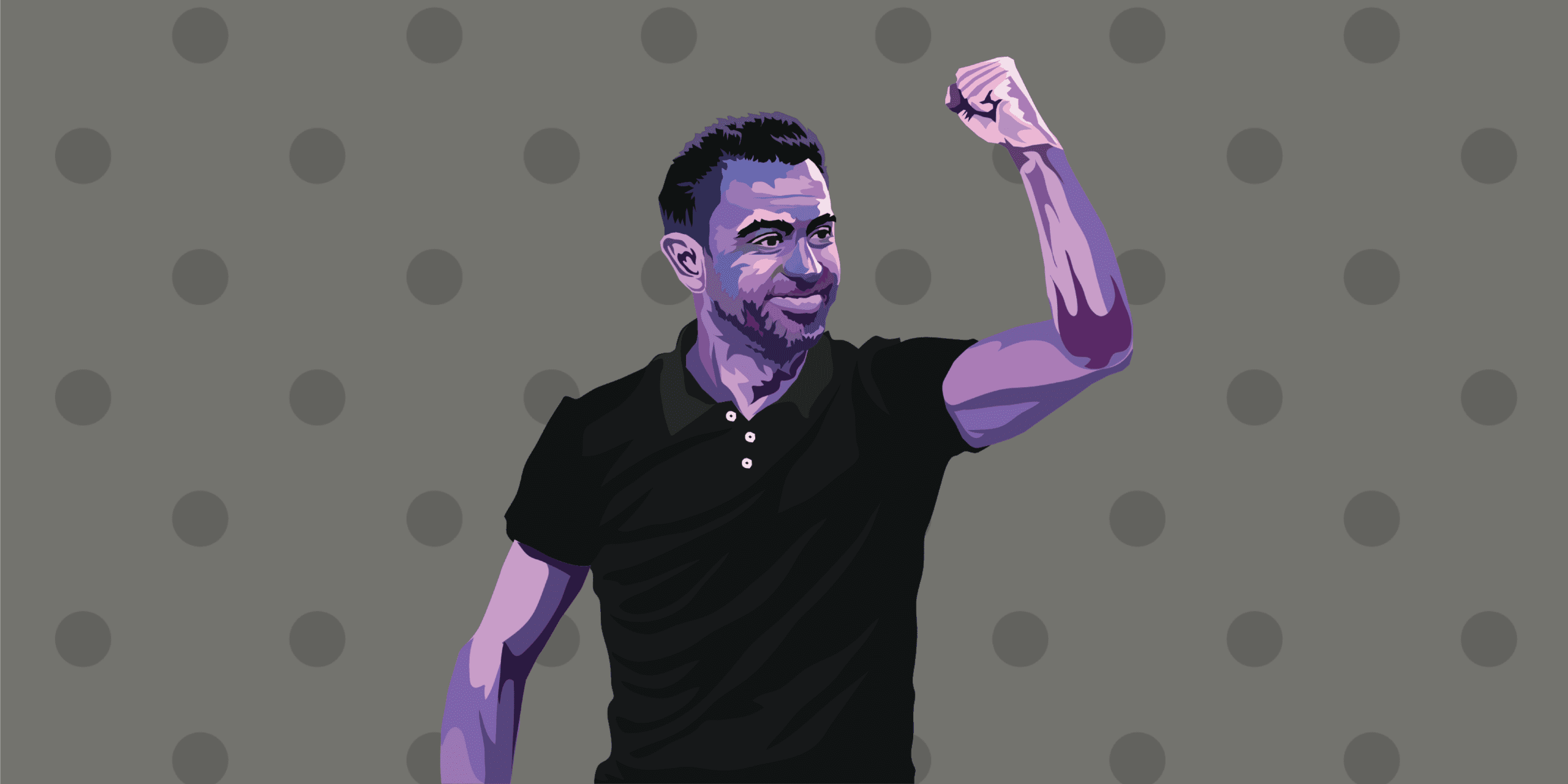




Comments